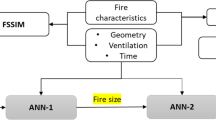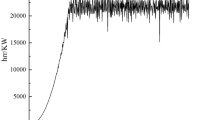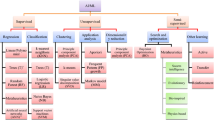Abstract
This paper presents a data-driven approach that can provide the most suitable decision to the mine firefighting personnel in real time during ongoing underground coal mine fires. The approach uses a feed-forward artificial neural network (ANN) to classify fires to provide the best decision considering only parameters measurable in underground coal mines. Additionally, the methodology along with the concepts that should be considered to elaborate a data-driven approach of this type are detailed. A total of 500 fire scenarios with different fire size, air velocity, fire growth rate, and entry dimensions were simulated in Fire Dynamics Simulator (FDS) and Fire and Smoke Simulator (FSSIM) for data generation to train and test the model. Results show that the ANN predicted fire classes with an accuracy and weighted-average F1-score equals to 97% and 96.7% for training and testing dataset, respectively. Results also show that 95% of ANN predictions of fire class change should not have a time gap greater than 18 s of the true fire class change for any fire position in the tunnel. Furthermore, the impact of fuel uncertainty during mine fires and how to address it is discussed in this paper. While the model presented in this work was designed to classify fires in a regular elongated coal mine entry, the same methodology could be applied to classify fires in other scenarios with similar geometry, such as road tunnels.


















Similar content being viewed by others
Availability of data and material
All datasets and codes used for supporting the conclusions of this article are available upon request at the following website: https://drive.google.com/drive/folders/1wRFvfTG_pTk0GRNUZWRfOGRDrcDSLWNA?usp=sharing.
References
Abadi M, Agarwal A, Barham P, Brevdo E, Chen Z, Citro C, Corrado GS, Davis A, Dean J, Devin M, Ghemawat S, Goodfellow I, Harp A, Irving G, Isard M, Jia Y, Jozefowicz R, Kaiser L, Kudlur M, Levenberg J, Mane D, Monga R, Moore S, Murray D, Olah C, Schuster M, Shlens J, Steiner B, Sutskever I, Talwar K, Tucker P, Vanhoucke V, Vasudevan V, Viegas F, Vinyals O, Warden P, Wattenberg M, Wicke M, Yu Y, Zheng X (2016) TensorFlow: large-scale machine learning on heterogeneous distributed systems. arXiv:1603.04467
Alwosheel A, van Cranenburgh S, Chorus CG (2018) Is your dataset big enough? Sample size requirements when using artificial neural networks for discrete choice analysis. J Choice Model 28:167–182. https://doi.org/10.1016/j.jocm.2018.07.002
Brake DJ (2013) Fire modelling in underground mines using Ventsim Visual VentFIRE Software. In: The Australian Mine Ventilatoin Conference. Adelaide
Buffington T, Cabrera JM, Kurzawski A, Ezekoye OA (2020) Deep-learning emulators of transient compartment fire simulations for inverse problems and room-scale calorimetry. Fire Technol. https://doi.org/10.1007/s10694-020-01037-2
Chollet F (2015) Keras. https://github.com/fchollet/keras
Conti RS, Chasko LL, Wiehagen WJ, Lazzara CP (2000) An underground coal mine fire preparedness and response checklist: the instrument. Tech. rep, Pittsburgh
Conti RS, Chasko LL, Wiehagen WJ, Lazzara CP (2005) Fire response preparedness for underground mines. Tech rep, NIOSH
De Rosa MI (2004) Analysis of mine fires for all U.S. underground and surface coal mining categories: 1990-1999. National Institute for Occupational Safety and Health, Centers for Disease Control and Prevention pp. 1–36
Floyd JE, Hunt SP, Williams FW, Tatem PA (2005) A network fire model for the simulation of fire growth and smoke spread in multiple compartments with complex ventilation. J Fire Prot Eng. https://doi.org/10.1177/1042391505051358
Fridolf K, Andrée K, Nilsson D, Frantzich H (2014) The impact of smoke on walking speed. Fire Mater 38(7):744–759
Gehandler J, Ingason H, Lönnermark A, Frantzich H, Strömgren M (2013) Performance-based requirements and recommendations for fire safety in road tunnels (FKR-BV12)
Goodfellow I, Bengio Y, Courville A (2016) Deep learning. https://www.deeplearningbook.org/
Grieco E, Bernardi M, Baldi G (2008) Pyrolysis Styrene - butadiene rubber pyrolysis: products, kinetics, modelling. J Anal Appl Pyrol 82:304–311. https://doi.org/10.1016/j.jaap.2008.05.004
Hadjisophocleous G, Jia Q (2009) Comparison of FDS prediction of smoke movement in a 10-Storey building with experimental data. Fire Technol 45(2):163–177. https://doi.org/10.1007/s10694-008-0075-3
Haghighat A, Luxbacher K (2018) Tenability analysis for improvement of firefighters‘ performance in a methane fire event at a coal mine working face. J Fire Sci 36(3):256–274. https://doi.org/10.1177/0734904118767066
Hodges JL (2018) Predicting large domain multi-physics fire behavior using artificial neural networks. Phd dissertation, Virginia Tech
Hodges JL, Lattimer BY, Luxbacher KD (2019) Compartment fire predictions using transpose convolutional neural networks. Fire Saf J 108(2018):102854. https://doi.org/10.1016/j.firesaf.2019.102854
ICIS: Styrene-Butadiene Rubber (SBR) Uses and Outlook - ICIS Explore (2010). https://www.icis.com/explore/resources/news/2007/11/06/9076467/styrene-butadiene-rubber-sbr-uses-and-outlook/
Ingason H (1995) Design fires in tunnels. In: Conference Proceedings of Asiaflam 95, pp. 77–86. Hong Kong
Ingason H, Li YZ, Lönnermark A (2015) Tunnel fire ventilation. In: Tunnel fire dynamics, vol. 53, pp. 333–360. Springer New York, New York, NY. https://doi.org/10.1007/978-1-4939-2199-7. https://www.cambridge.org/core/product/identifier/CBO9781107415324A009/type/book_parthttp://link.springer.com/10.1007/978-1-4939-2199-7
Kerber S, Milke JA (2007) Using FDS to simulate smoke layer interface height in a simple atrium. Fire Technol 43(1):45–75. https://doi.org/10.1007/s10694-007-0007-7
Lattimer B, Hodges J, Lattimer A (2020) Using machine learning in physics-based simulation of fire. Fire Saf J 114:102991. https://doi.org/10.1016/j.firesaf.2020.102991
Lee J, Lee S, You D (2018) Deep learning approach in multi-scale prediction of turbulent mixing-layer pp. 1–21. arXiv:1809.07021
Lee S, You D (2017) Prediction of laminar vortex shedding over a cylinder using deep learning (Wu 2011). arXiv:1712.07854
Li YZ, Ingason H (2017) Effect of cross section on critical velocity in longitudinally ventilated tunnel fires. Fire Saf J 91:303–311. https://doi.org/10.1016/j.firesaf.2017.03.069
Li YZ, Lei B, Ingason H (2010) Study of critical velocity and backlayering length in longitudinally ventilated tunnel fires. Fire Saf J 45(6–8):361–370. https://doi.org/10.1016/j.firesaf.2010.07.003
Lin JP, Chang CY (1996) Pyrolytic treatment of rubber waste: pyrolysis kinetics of styrene-butadiene rubber. J Chem Technol Biotechnol 66:7–14
Maevski I (2011) Tenable Environment- Literature Review. In: Design fires in road tunnels, chap. Three, pp. 323–332. https://doi.org/10.17226/14562
Maulik R, San O (2017) A neural network approach for the blind deconvolution of turbulent flows. J Fluid Mech 831:151–181. https://doi.org/10.1017/jfm.2017.637
McGrattan K, Hostikka S, Floyd J, Baum H, Rehm RG (2018) Fire dynamics simulator (Version 6), Technical Reference Guide. NIST - Spec. Publ. http://www.ncbi.nlm.nih.gov/pubmed/8409852
McGrattan KB, Forney GP (2004) Fire dynamics simulator (version 4): user’s guide. Tech. rep., National Institute of Standards and Technology, Gaithersburg, MD. https://doi.org/10.6028/NIST.SP.1019. https://nvlpubs.nist.gov/nistpubs/Legacy/SP/nistspecialpublication1019.pdf
Mcpherson MJ (1993) Chapter 21: Fires and explosions. In: Subsurface ventilation engineering, first edn
Miyanawala TP, Jaiman RK (2017) An efficient deep learning technique for the Navier-Stokes equations: application to unsteady wake flow dynamics. arXiv:1710.09099
NFPA: NFPA 502: Standard for Road Tunnels, Bridges, and Other Limited Access Highways (2020). https://www.nfpa.org/codes-and-standards/all-codes-and-standards/list-of-codes-and-standards/detail?code=502
NIOSH: 1988 OSHA PEL Project Documentation (1988). https://www.cdc.gov/niosh/pel88/npelname.html
Oka Y, Atkinson GT (1995) Control of smoke flow in tunnel fires. Fire Saf J 25(4):305–322. https://doi.org/10.1016/0379-7112(96)00007-0
Raissi M, Yazdani A, Karniadakis GE (2018) Hidden fluid mechanics: a Navier-Stokes informed deep learning framework for assimilating flow visualization data. arXiv:1808.04327
Rowland JH, Harteis SP, Yuan L (2018) A survey of atmospheric monitoring systems in US underground coal mines. Min Eng 70(2):37–40
Shen TS, Huang YH, Chien SW (2008) Using fire dynamic simulation (FDS) to reconstruct an arson fire scene. Build Environ 43(6):1036–1045. https://doi.org/10.1016/j.buildenv.2006.11.001
Tewarson: Chapter 4: generation of heat and chemical compounds in fires. In: SFPE Handbook of Fire Protection Engineering, Third Edition, chap. Section Th, pp. Section 3–111 (2002)
Tewarson A, Jiang FH, Morikawa T (1993) Ventilation-controlled combustion of polymers. Combust Flame 169:151–169
Thomas PH (1968) The movement of smoke in horizontal passages against an air flow. Fire Research Station (723)
US Code of Federal Regulations: CFR, title 30 (mineral resources) part 75. Mandatory safety standards-underground coal mines (2016). https://www.msha.gov/regulations/standards-regulations
Vauquelin O (2005) Parametrical study of the back flow occurrence in case of a buoyant release into a rectangular channel. Exp Thermal Fluid Sci 29(6):725–731. https://doi.org/10.1016/j.expthermflusci.2005.01.002
Wu Y, Bakar MZ (2000) Control of smoke flow in tunnel fires using longitudinal ventilation systems - a study of the critical velocity. Fire Saf J 35(4):363–390. https://doi.org/10.1016/S0379-7112(00)00031-X
Yu LX, Beji T, Maragkos G, Liu F, Weng MC, Merci B (2018) Assessment of numerical simulation capabilities of the fire dynamics simulator (FDS 6) for planar air curtain flows. Fire Technol 54(3):583–612. https://doi.org/10.1007/s10694-018-0701-7
Yuan L, Litton CD (2007) Experimental study of flame spread on conveyor belts in a small-scale tunnel. National Institute for Occupational Safety and Health
Yuan L, Mainiero RJ, Rowland JH, Thomas RA, Smith AC (2014) Numerical and experimental study on flame spread over conveyor belts in a large-scale tunnel. J Loss Prev Process Ind 30:55–62. https://doi.org/10.1016/j.jlp.2014.05.001
Yuan L, Thomas RA, Zhou L (2017) Characterization of a mine fire using atmospheric monitoring system sensor data. Min Eng 69(6):57–62
Acknowledgements
This research was supported by Contract No. 200-2014-59669, awarded by the National Institute for Occupational Safety and Health (NIOSH). The findings and conclusions in this report are those of the authors and do not reflect the official policies of the Department of Health and Human Services; nor does mention of trade names, commercial practices, or organizations imply endorsement by the U.S. Government.
Funding
This research was funded by the National Institute Safety and Health (NIOSH) under contract No. 200-2014-59669.
Author information
Authors and Affiliations
Corresponding author
Ethics declarations
Conflict of interest
The authors declare that they have no conflict of interest.
Additional information
Publisher's Note
Springer Nature remains neutral with regard to jurisdictional claims in published maps and institutional affiliations.
Rights and permissions
About this article
Cite this article
Barros-Daza, M.J., Luxbacher, K.D., Lattimer, B.Y. et al. Real Time Mine Fire Classification to Support Firefighter Decision Making. Fire Technol 58, 1545–1578 (2022). https://doi.org/10.1007/s10694-022-01215-4
Received:
Accepted:
Published:
Issue Date:
DOI: https://doi.org/10.1007/s10694-022-01215-4




